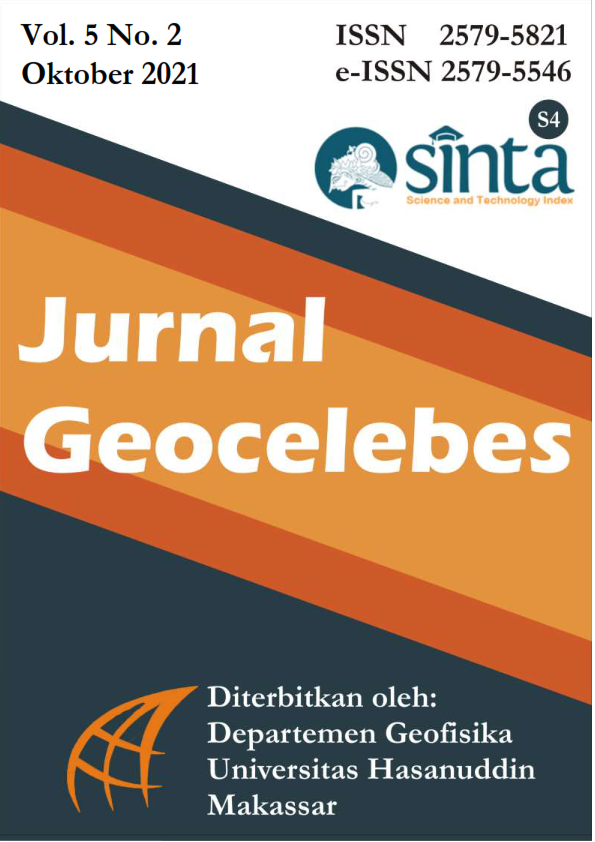Penerapan Persamaan Trend Surface Analysis untuk Pemisahan Anomali Residual dan Regional pada Data Gayaberat
DOI:
https://doi.org/10.20956/geocelebes.v5i2.14023Keywords:
Anomali Regional, Anomali Residual, Pemisahan anomali, Trend Surface AnalysisAbstract
The separation of regional anomalies and residual anomalies in gravity data is an important part in interpreting gravity data. This process aims to obtain gravity anomalies that have been associated with exploration targets. The Trend Surface Analysis method is a mathematical approach to the earth field that can be used to separate maps into regional components and local components. The application of this method into gravity data can be used to separate regional anomalies and residual anomalies. The process of processing the trend surface analysis method can be done using Microsoft Excel. This method is tested first on synthetic gravity data, the purpose of this test is to determine the performance of the trend surface analysis method in performing anomaly separation. Based on the test results of the trend surface analysis method on synthetic gravity data, it was found that this method was quite good at separating regional anomalies and residual anomalies. This is evidenced by the anomalous pattern that is already the same between the regional gravity anomaly resulting from the separation of the anomaly using the trend surface analysis method and the regional anomaly resulting from synthetic data. The same anomaly pattern can also be seen in the residual anomaly resulting from the separation of the anomaly using the trend surface analysis method with the residual anomaly resulting from synthetic data. The application of the trend surface analysis method to field data has been carried out by producing regional anomalies and residual anomalies. This method is very good at separating regional anomalies and residual anomalies, especially in regional anomalies located at deep depths.Pemisahan anomali regional dan anomali residual pada data gayaberat merupakan bagian penting dalam
melakukan interpretasi data gayaberat. Proses ini bertujuan untuk mendapatkan anomali gayaberat yang
sudah berasosiasi dengan target eksplorasi. Metode Trend Surface Analysis merupakan teknik
pendekatan matematika pada bidang kebumian yang dapat digunakan untuk memisahkan peta kedalam
komponen regional dan komponen lokal. Penerapan metode ini ke dalam data gayaberat dapat
digunakan untuk memisahkan anomali regional dan anomali residual. Proses pengolahan metode trend
surface analysis dapat dilakukan dengan menggunakan microsoft excel. Metode ini diuji terlebih dahulu
pada data gayaberat sintetis, tujuan pengujian ini adalah untuk mengetahui performa metode trend
surface analysis dalam melakukan pemisahan anomali. Berdasarkan hasil pengujian metode trend
surface analysis pada data gayaberat sintetis didapatkan bahwa metode ini cukup baik dalam
memisahkan anomali regional dan anomali residual. Hal ini dibuktikan pada pola anomali yang sudah
sama antara anomali gayaberat regional hasil pemisahan anomali metode trend surface analysis dengan
anomali regional hasil data sintetis. Pola anomali yang sama juga dapat dilihat pada anomali residual
hasil pemisahan anomali metode trend surface analysis dengan anomali residual hasil data sintetis.
Penerapan metode trend surface analysis pada data lapangan telah dilakukan dengan menghasilkan
anomali regional dan anomali residual. Metode ini sangat baik dalam memisahkan anomali regional
dan anomali residual terutama pada anomali regional yang berada pada kedalaman dalam
References
Abdelrahman, E.M., Riad, S., Refai, E. and Amin, Y. 1985. On the least-squares residual anomaly determination. Geophysics. 50(3), pp.473–480. doi: 10.1190/1.1441925.
Abokhodair, A.A. 2011. Constrained polynomial fitting for recovery of regional gravity. Geophysical Prospecting. 59(4), pp.749–759. doi: 10.1111/j.1365-2478.2011.00945.x.
Beltrao, J. F., Silva, J.B.C. and Costa, J.C. 1991. Robust polynomial fitting method for regional gravity estimation. Geophysics. 56(1), pp.80–89. doi: 10.1190/1.1442960.
Blakely, R.J. 1995. Potential Theory in Gravity and Magnetic. doi: 10.1017/CBO9780511549816.
Davis, J.C. 2002. Statistics and Data Analysis in Geology -Wiley (2002).pdf.
Grandis, H. and Dahrin, D. 2014. Constrained Two-Dimensional Inversion of Gravity Data. Journal of Mathematical and Fundamental Sciences. 46(1), pp.1–13. doi: 10.5614/j.math.fund.sci.2014.46.1.1.
Guo, L., Meng, X., Chen, Z., Li, S. and Zheng, Y. 2013. Preferential filtering for gravity anomaly separation. Computers and Geosciences. 51, pp.247–254. doi: 10.1016/j.cageo.2012.09.012.
Gupta, V. K. and Ramani, N. 1980. Some aspects of regional-residual separation of gravity anomalies in a Precambrian terrain. Geophysics. 45(9), pp.1412–1426. doi: 10.1190/1.1441130.
Keating, P. and Pinet, N. 2011. Use of non-linear filtering for the regional-residual separation of potential field data. Journal of Applied Geophysics. 73(4), pp.315–322. doi: 10.1016/j.jappgeo.2011.02.002.
Martín, A., Núñez, M.A., Gili, J.A. and Anquela, A.B. 2011. A comparison of robust polynomial fitting, global geopotential model danspectral analysis for regional-residual gravity field separation in the Doñana National Park (Spain). Journal of Applied Geophysics. 75(2), pp.327–337. doi: 10.1016/j.jappgeo.2011.06.037.
Menke, W. 2012. Geophysical Data Analysis: Discrete Inverse Theory. New York: Academic Press. doi: 10.1016/b978-0-12-397160-9.00001-1.
Nettleton, L.L. 2014. Elementary Gravity and Magnetics for Geologists and Seismologists. doi: 10.1190/1.9781560802433.
Nishijima, J. and Naritomi, K. 2017. Interpretation of gravity data to delineate underground structure in the Beppu geothermal field, central Kyushu, Japan. Journal of Hydrology: Regional Studies. 11, pp.84–95. doi: 10.1016/j.ejrh.2015.11.022.
Obasi, A.I., Onwuemesi, A.G. and Romanus, O.M. 2016. An enhanced trend surface analysis equation for regional–residual separation of gravity data. Journal of Applied Geophysics. 135, pp.90–99. doi: 10.1016/j.jappgeo.2016.09.023.
Pawlowski, R.S. and Hansen, R.O. 2002. Gravity anomaly separation by Wiener filtering. Geophysics. 55(5), pp.539–548. doi: 10.1190/1.1442865.
Selim, E.S.I. and Aboud, E. 2014. Application of spectral analysis technique on ground magnetic data to calculate the Curie depth point of the eastern shore of the Gulf of Suez, Egypt. Arabian Journal of Geosciences. 7(5), pp.1749–1762. doi: 10.1007/s12517-013-0868-7.
Shuey, R.T., Schellinger, D.K., Tripp, A.C. and Ai, L.B. 1977. Curie depth determination from aeromagnetic spectra. Geophysical Journal of the Royal Astronomical Society. 50(1), pp.75–101. doi: 10.1111/j.1365-246X.1977.tb01325.x.
Simpson, S.M. 1954. Least Squares Polynomial Fitting to Gravitational Data and Density Plotting By Digital Computers. Geophysics. pp.255–269. doi: 10.1190/1.1437990.
Skeels, D.C. 1967. What is residual gravity. Geophysics. 32(5), pp.872–876. doi: 10.1190/1.11439896
Spector, A. and Grant, F.S. 1970. Statistical models for interpreting aeromagnetic data. Geophysics. 35(2), pp.239-302. doi: 10.1190/1.1440092
Unwin, D. 1978. An introduction to trend surface analysis. Concepts and techniques in modern geography, 5, pp.1–40.
Xu, W. and Chen, S. 2018. A case study of forward calculations of the gravity anomaly by spectral method for a three-dimensional parameterised fault model. Computers and Geosciences. 111 (September 2017), pp.67–77. doi: 10.1016/j.cageo.2017.11.001.
Xu, Y., Hao, T., Li, Z., Duan, Q. and Zhang, L. 2009. Regional gravity anomaly separation using wavelet transform and spectrum analysis. Journal of Geophysics and Engineering. 6(3), pp.279–287. doi: 10.1088/1742-2132/6/3/007.
Downloads
Published
How to Cite
Issue
Section
License
Authors who publish with this journal agree to the following terms:
- Authors retain copyright and grant the journal right of first publication with the work simultaneously licensed under a Creative Commons Attribution License that allows others to share the work with an acknowledgement of the work's authorship and initial publication in this journal.
- Authors are able to enter into separate, additional contractual arrangements for the non-exclusive distribution of the journal's published version of the work (e.g., post it to an institutional repository or publish it in a book), with an acknowledgement of its initial publication in this journal.
- Authors are permitted and encouraged to post their work online (e.g., in institutional repositories or on their website) prior to and during the submission process, as it can lead to productive exchanges, as well as earlier and greater citation of published work (See The Effect of Open Access).





